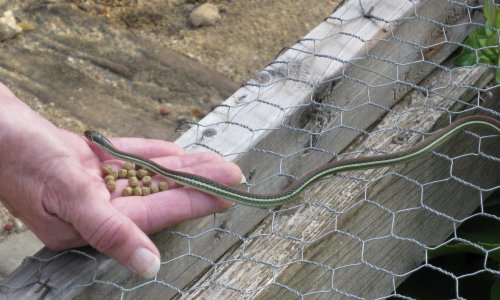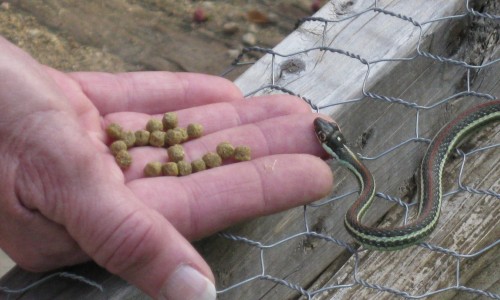Q&A: Feeding a Ribbon Snake in the Backyard
Earlier this month, Daryl Frese wrote to me with an interesting story about a snake that kept coming for a visit.
We live near San Antonio, Texas. We have water gardens and fish ponds and have had garter snakes for the last few years that would show up at feeding time for the fish. We have always had fun watching them eat and learning their different personalities. This year, we have one that seemed a little bit more comfortable binging around us. After a few weeks of it coming closer and closer to us, my wife decided to put some food in her hand and see what would happen, and sure enough it came up and took the food out of her hand.
Is it OK to keep feeding her this way? We have started digging up earthworms and letting her (him) have a treat. She shows up about every three days, comes over to my wife and begs for dinner.
I wrote back to say that I couldn’t see any harm in it. While conventional wisdom is that feeding wild animals is a bad idea, I suspect that’s because there are real dangers for both animal and people alike when certain species get acclimated. An animal that becomes used to human contact can be dangerous if it’s a predator, but more generally is less able to fend for itself. I don’t think a wild snake’s ability to survive is going to be impeded by being hand-fed by humans every now and then.
Things got more interesting when Daryl sent along a couple of photos of said snake begging for food (note the finger the snake is chewing on in the second photo).


Because that’s a Red-striped Ribbon Snake, Thamnophis proximus orarius, one of six subspecies of Western Ribbon Snake, and that snake is doing what I don’t normally expect ribbon snakes to do. As I’ve written before, ribbon snakes are not necessarily the tamest snakes out there. They’re certainly active and inquisitive, but normally nervous. Of course, as I went on to say in that article, I had my own experience with a calm Northern Ribbon Snake (Thamnophis sauritus septentrionalis) and her babies, which challenged my expectations of how ribbon snakes behaved.
A wild ribbon snake that is so accustomed to the presence of people that it can take food from a person’s hands also challenges those expectations. (The fact that the snake is, in the second photo, biting the hand that feeds it does not matter: I’ve seen plenty of bites like that from tame, but ravenous, snakes in my care. A nervous wild ribbon snake would be more likely to thrash and musk than to try to eat your finger.)
The other thing that surprised me was that the snake was being fed earthworms, which I didn’t think ribbon snakes ate; I thought they specialized in amphibians and fish. So I checked my books. Alan Tennant mentions foraging for earthworms on land in his listing for Red-striped Ribbon Snakes in his field guides,1 but he’s the only one. In an article published in the Texas Journal of Science in 1954,2 M. J. Fouquette, Jr., found that in Texas, amphibians made up 82 percent of the Western Ribbon Snake’s diet; neither Ernst and Ernst (2003) nor Rossman, Ford and Seigel (1996), who cite Fouquette’s article, mention earthworms as part of a ribbon snake’s diet. Nor, for that matter, do Rossi and Rossi (2005) or Werler and Dixon (2000). Ribbon snakes are widely seen as snakes with narrow prey preferences.3
But, as my late friend Mike Rankin would say, snakes don’t read books. Which makes Daryl’s backyard encounter with this Red-striped Ribbon Snake very interesting indeed, on several levels.
Notes
- In Tennant (1998), p. 78, and Tennant and Bartlett (2000), p. 122.
- Here is the reference, though I have not seen it: Fouquette, M. J., Jr. (1954). Food competition among four sympatric species of garter snakes, genus Thamnophis. Texas J. Sci 6:172-189.
- With regard to Eastern Ribbon Snakes, Thamnophis sauritus, Rossman, Ford and Seigel (1996) report that earthworms were refused in one study; Rossi and Rossi (2005) say that earthworms “are not thought to be taken by most populations of this snake” (p. 389).
Bibliography
Ernst, Carl H. and Evelyn M. Ernst. 2003. Snakes of the United States and Canada. Washington and London: Smithsonian Books.
Rossi, John V. and Roxanne Rossi. 2005. Snakes of the United States and Canada: Natural History and Care in Captivity. Malabar FL: Krieger.
Rossman, Douglas A., Neil B. Ford and Richard A. Seigel. 1996. The Garter Snakes: Evolution and Ecology. Norman and London: University of Oklahoma Press.
Tennant, Alan 1998. A Field Guide to Texas Snakes, 2nd. ed. Houston: Gulf.
——— and R. D. Bartlett. 2000. Snakes of North America: Eastern and Central Regions. Houston: Gulf.
Werler, John E. and James R. Dixon. 2000. Texas Snakes: Identification, Distribution, and Natural History. Austin: University of Texas Press.